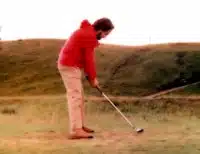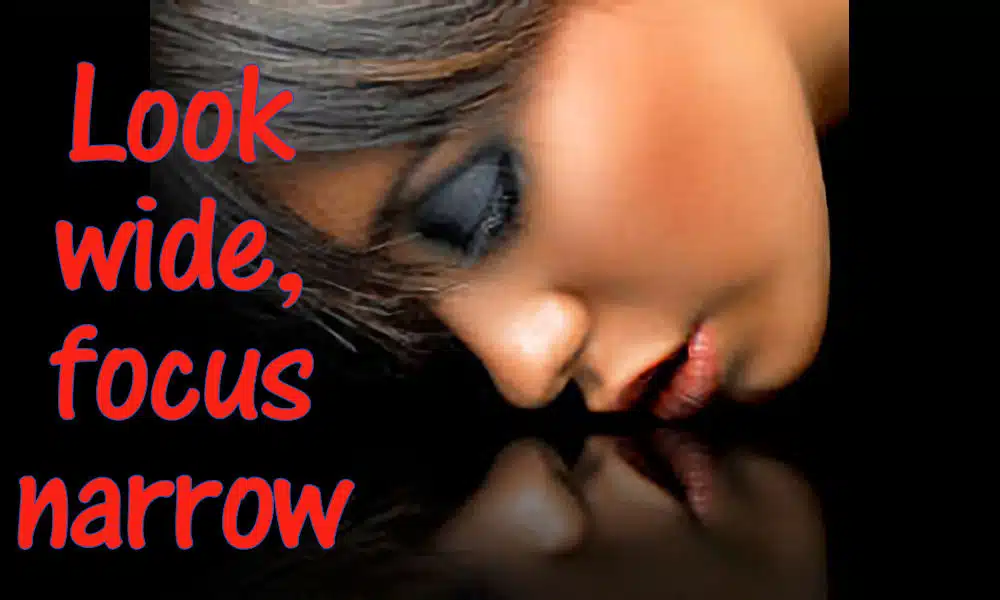Look Wide, Focus Narrow — learning to shift your focus means you automatically see a “bigger picture”

Want to learn more about living a full and meaningful life?
Want to have the best relationship ever?
Check out my books
Not long ago, I was rooting around in some old photos, and I came upon one of me playing golf. In Scotland, in 1986. I stopped playing golf many years ago, paradoxically after 2 great years of finally being able to break 90 every time.
Here’s a thought: A wide focus or a narrow focus isn’t enough. What we need is a divergent focus. In life as in golf, we need to create multiple foci.
Anyway, here are two golf stories.

I started playing golf in High School, and got serious about it during Seminary.
One of the guys in my class had been a semi-pro; he’d tried the Canadian Pro Tour, but couldn’t handle the stress and pressure, so he decided to be a Minister. (I’m grinning as I write this–talk about “out of the frying pan, into the fire.” ? )
He and I would go golfing regularly.
Me, I was an average hacker; I thought it remarkable when I finally broke 100 on a regular basis.
Like most “hackers,” I had a wicked slice. I often played on the adjacent fairway, so off track were my fairway shots.
I bought golf books; I bought golf magazines. Over and over, I read that I should correct my slice by adjusting my grip.
This involves rotating your hands on the handle of the club, so that the swing-through puts a spin on the ball to counter the spin that causes the slice.
In practice, what this meant was that no matter how hard I tried, I couldn’t get distance. All of my swing’s energy was lost as the counter-spin fought for control of the ball.
And accuracy was out of the question.
A couple of decades later, Darbella decided to take up golf, and booked lessons. (She’d seen my slice, so she didn’t ask me… 😉 )
Lessons had never occurred to me, as “Real men don’t need no stinkin’ lessons.” I was self-taught, and proud of it.
But a little voice inside that I trust piped up and said, “Can’t hurt.”
Dar and I had simultaneous lessons, and Susan, the woman who instructed us, was “up there” in the ranks of Canadian pros.
She instructed me to tee up, take a 5‑iron, and hit a green 150 feet out. I gulped, teed up a ball, grabbed my trusty 5‑iron, and gripped the club in my choked, “correct the slice” grip.
She fairly flew to my side. “Whoa! Relax! Take a neutral grip!”
I demurred, saying that if I did, someone standing to my right was going to have a golf ball in his/her ear. She insisted, and backed up, letting me swing. Sure enough, the ball took off, turned 90 degrees to the right and landed 150 feet out and about 50 feet to the side of the green.
I won’t bore you with the conversation, but Susan walked up to me and said, “OK. Swing slowly and stop at the top of your swing.” I did.
She told me to hold the club at the top. She then proceeded to completely alter my posture at the end of my swing.
She pivoted my hips, re-set the position of my club and otherwise fiddled with my anatomy until I was in an completely unfamiliar and, of course, uncomfortable, posture.
As is typical of new things…
She said, “Memorize this posture with your body.” Having done Martial Arts for decades, that directive actually made sense.
She then directed me to swing at half speed (no ball, just a tee for a target) and be sure each time I swung that I ended up in the new position.
I started, and she went to work on Dar.
After 50 swings she yelled over and told me to practice swing at full speed.
After another 20 minutes of air-ball, she sauntered over, teed up a ball for me, and told me to hit the green. I started into my, “But you saw what happened last time; I have to correct my grip” whine.
She looked me square in the eye, and said something I said to clients for my entire career (except for the golf part…):
“If you focus on the results you want, and finish the swing in the ending posture you’ve been practicing, everything will take care of itself.”
As I said, I recognized the idea, and thought, “Well, that might apply to life, but it can’t apply to golf.”
But I’d paid my money, so I decided to risk it.
I took a swing, forced my club to end up where I was “supposed to,” and my ball sailed out 175 yards, dead straight, and past the pin. I realized that, for years, I’d been hitting 25 yards too hard, to compensate for my slice.
No wonder a round of golf was so exhausting–Screwing up takes energy.
I was going to write that Susan smiled; she actually smirked.
I hit a succession of balls, and 90% went straight. If I “lost” the end position, I sliced. If I “found” the end position the ball went straight. My game dropped into the low 90s immediately, and within a month or so, I was hitting the occasional 88.
My “problem” was that my entire focus was on my slice. Everything I did, every shot I planned, every approach I contemplated, had as it’s goal, “How can I do this and minimize the damage of my uncontrolled slice?”
What this meant, in practical terms, is that I was spending so much time compensating for my slice, that I never allowed for the possibility that I didn’t have one!
Susan came along and reset my entire game by teaching me to fix my presuppositions.

My first and most popular book,
This Endless Moment.
Learn to live a full and satisfying life.
As soon as I stopped acting like I had a slice, and then compensating for it, I no longer had a slice.
By focusing wide (seeing myself as a golfer, not a golfer with a slice) and then describing the behaviour and actions I wanted to achieve (the setting up of the end posture,) I could “focus narrow” on the actual target. (Of course, then I actually had to continually do the new behaviour!!!)
Notice how much better this is than simply accepting my fate as a “slicer,” narrowing down my game to compensating for that, and never, ever being able to pick a target for my ball.
The other golf story is shorter.
The idea of look wide, focus narrow applies in other ways.
There were many occasions where I’d march up to my ball, look at the pin, grab a club, adopt my stance, visualize the shot, remember my ending posture, gauge the distance, and swing the club. My contact was perfect, with exactly the right swing speed.
Off the ball would lift, heading dead for the pin, only to collide with the branch sticking out into the fairway.
My narrow focus was perfect… if only that damn branch wasn’t there.
Had I looked wide, I’d have seen it, but then I couldn’t blame the tree ?
I was talking with a friend who is narrowly focussed on his relationship failures. He is expert at seeing what he does wrong, and focussing on that for… years. As a result, he’s often shut down, sad, etc.
He is narrowly focussed on his own mistaken belief (like my years of thinking I was slicer…) about his ability to relate with elegance, despite the fact that he does… with almost everyone.
But he is heavily invested in being the “one to blame.” His focus is on that, and that alone.
I regularly invite him to look wider. To see the games everyone is playing… it’s not just him. As he widens his gaze, he might actually notice the things he was pushing out of his viewpoint–like that he’s actually a pretty good “relater.”
From there, from the wider view, the hard work begins. He needs a clean swing and a focussed belief in himself… and that flies in the face of what he continually tells himself.
Life situations are always bigger than we perceive them to be, and never more so than when we are setting ourselves up to have a problem over something or with someone.
When in conflict, we let ourselves be pulled into the drama (the ineffectual story,) and all evidence of “things to the contrary” fall by the wayside.
Like the branch overhanging the fairway, they are there, but unnoticed, because we simply refuse to look for “surprises.”
Getting past this requires new thinking, followed by new behaviour. Every time. To beat the golf analogy to death, I had to give up my grip correction forever, and swing in a new and initially uncomfortable, unfamiliar way. If I went back to correcting, I lost control.
The new behaviour does become habitual; it just takes a ton of practice, and no excuses.
And then, we play a harder course, or a branch sticks out.
If we stay completely focussed on technique, we miss subtle changes and set-ups that will lead to missed shots or bad lies. The only hope is to learn to focus narrow, THEN look wide — and with practice (again!) see the little things that have arisen “this time.”
But then, it’s right back to the new way of doing things, PLUS an adjustment to compensate for the thing you’ve spotted. You turn your feet a bit, and swing.
Notice your “compensating behaviours.”
- What are you doing to justify clinging to a dysfunctional view of yourself?
- Who are you blaming for your dramas?
- Who are you looking for to rescue you?
- What would happen if you stopped whining about how tough your life is, and simply looked wide, noticed how “perfect” life is, and then focussed narrow on choosing to live your life for a position of comfort and assurance?
It’s your game. Maybe it’s time to choose to lower your handicap.

